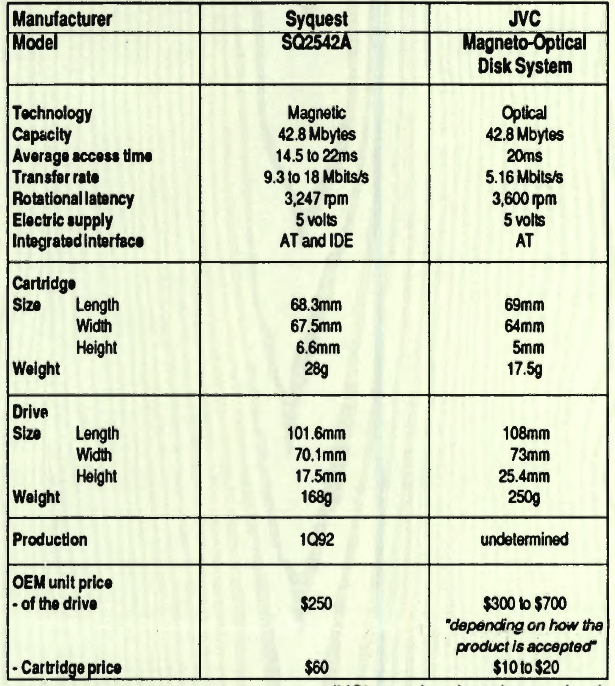History (1991): Hatchet Unburried Between Magnetic and Optical Drive
2.5-inch drives with removable media, one magnetic from Syquest, other one optical from JVC, offer very similar characteristics.
By Jean Jacques Maleval | May 14, 2020 at 2:35 pmTwo new 2.5-lnch drives with removable media, one magnetic from Syquest, the other one optical from JVC, offer very similar characteristics.
Until now, HDDs were considered as the ideal basic way to store data. Digital optical disks only came second in this memory hierarchy for backing up and archiving.
But since Comdex, computer manufacturers and integrators looking for storage peripherals, will have to start wondering as optical drives have considerably improved and their performances are closely approaching those of Winchester drives.
The best way to prove it is by comparing two storage products among the most remarkable ones seen in Las Vegas, NV. One is an optical drive and the other is magnetic, they both use removable 2.5-inch 43MB media.
They look like a cartridge with a surface 2x smaller than a 3.5-inch diskette and can easily fit in a wallet.
On one side Syquest Technology’s (Fremont, CA) 2542A unit is completely based on a magnetic recording technology just like a Winchester drive where JVC integrated an optical media brushed by a laser beam, even if it is referred to as magneto-optical technology.
The technical specs of these two peripherals are very close: capacity, access time, size, power consumption.
We’ll talk about the differences. The US company Syquest uses the long proven Winchester technology which leads to a cheaper drive, better MTBF and transfer rates. The unit incorporates three different seek times, 14.5, 17 or 22ms. Power consumption during seek time varies from 1 .4 to 2.2W, depending on the seek time used. The power-on to ready time is 3s.
The Japanese JVC offers a cheaper media but with a large margin to soon double its capacity. The optical media has better archiving abilities and can be used under 3 modes (completely rewritable, like an HDD, pre-written only readable like a CD-ROM, and finally partly rewritable and partly read-only.
Syquest had a hard time getting rid of a poor image it had acquired with its first cartridges that could not stand dust. This company is also used to launching products that never leave their laboratories.
But this time, on its booth it had integrated its drive in an operating Epson NB3S notebook computer and in an external version linked to a Zenith Masterport 386SL and a Toshiba T2000SX. The SQ2542A resulted from a development program between Iota Memories Corp. (Santa Clara, CA), a subsidiary of Iomega, launched in July 1990 and run by Joseph Davis and a team of former engineers from Maxtor.
JVC’s product is only a technology announcement to test the market.
Finally these drawbacks are only minor details.
As of now, hostilities have begun: magnetic drives will have to compete with optical ones as preferred storage support for microcomputers.
The first two 2.5-lnch drives with removable cartridges

This article is an abstract of news published on the former paper version of Computer Data Storage Newsletter on issue ≠46, published on November 1991.














 Subscribe to our free daily newsletter
Subscribe to our free daily newsletter

